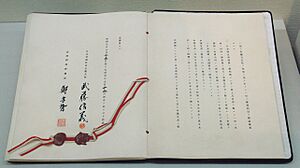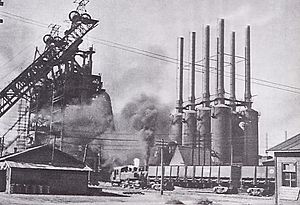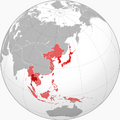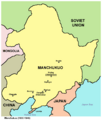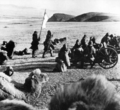Manchukuo facts for kids
Quick facts for kids
State of Manchuria (Manchukuo) (1932–1934)
滿洲國 Empire of (Great) Manchuria (1934–1945) (大)滿洲帝國 |
|||||||||
|---|---|---|---|---|---|---|---|---|---|
| 1932–1945 | |||||||||
|
Motto: "Five Races Under One Union"
|
|||||||||
|
Anthem: National Anthem of Manchukuo
|
|||||||||

Manchukuo (dark red) within the Empire of Japan (light red) at its furthest extent
|
|||||||||
| Status | Client state/Puppet state of the Empire of Japan | ||||||||
| Capital | Hsinking (Changchun) (until 9 August 1945) Tonghua (from 9 August 1945) |
||||||||
| Common languages | Japanese Manchu Mandarin Mongolian |
||||||||
| Religion | State Shinto | ||||||||
| Government | One-party constitutional monarchy under an authoritarian-personalist dictatorship | ||||||||
| Chief Executive | |||||||||
|
• 1932–1934
|
Aisin-Gioro Puyi | ||||||||
| Emperor | |||||||||
|
• 1934–1945
|
Aisin-Gioro Puyi | ||||||||
| Prime Minister | |||||||||
|
• 1932–1935
|
Zheng Xiaoxu | ||||||||
|
• 1935–1945
|
Zhang Jinghui | ||||||||
| Legislature | Legislative Council | ||||||||
| Historical era | Interbellum · World War II | ||||||||
|
• Proclaimed
|
18 February 1932 | ||||||||
| 15 August 1945 | |||||||||
| Area | |||||||||
| 1940 est. | 1,192,081 km2 (460,265 sq mi) | ||||||||
| Population | |||||||||
|
• 1940 est.
|
35,000,000 | ||||||||
| Currency | Manchukuo yuan | ||||||||
|
|||||||||
Manchukuo was a country in East Asia that existed from 1932 to 1945. It was located in a region called Manchuria, which is now part of China. Manchukuo was created and controlled by Japan during a time when Japan was expanding its power.
Even though Manchukuo had its own government, it was really a "puppet state" of Japan. This means Japan made all the important decisions. Manchukuo started as a republic, a country led by elected officials. But in 1934, it became a constitutional monarchy, which means it had an emperor whose power was limited by a set of rules.
The Start of Manchukuo
Manchuria was the homeland of the Manchu people. These included the rulers of the Qing dynasty, China's last royal family. In 1931, Japan took control of Manchuria after an event called the Mukden Incident. This incident was used by Japan as an excuse to invade.
After taking over, Japan set up a new government in Manchuria. This government was friendly to Japan. They chose Puyi, who was the last emperor of the Qing dynasty, to lead it. At first, Puyi was a "regent," meaning he ruled for someone else. Later, he became the emperor of Manchukuo.
Life in Manchukuo
Manchukuo was a diverse place. Most people living there were Han Chinese. However, there were also many Manchus, Koreans, Japanese, and Mongols. Some White Russians also lived there.
Japan controlled a small part of the southern Liaodong Peninsula directly. This area was called the Kwantung Leased Territory. Japan also built many factories and railways in Manchukuo. One important factory was the Showa Steel Works.
The End of Manchukuo
Manchukuo existed until 1945, when World War II ended. In August 1945, the Soviet Union invaded Manchukuo. Japan surrendered soon after, and Manchukuo's government was removed.
After the war, the Soviet Union gave the land back to China. This area became important for the Chinese Communist troops, led by Mao Zedong. They used the Japanese equipment left behind and gained an advantage in the Chinese Civil War.
Images for kids
-
Members of the Greater East Asia Co-Prosperity Sphere; territory controlled at maximum height. Japan and its allies in dark red; occupied territories/client states in lighter red. Korea and Taiwan were at that time considered integral parts of Japan and governed directly by the Japanese government, unlike client states such as Manchukuo that functioned under puppet governments.
-
Puyi as Emperor Kangde of Manchukuo.
See also
 In Spanish: Manchukuo para niños
In Spanish: Manchukuo para niños




